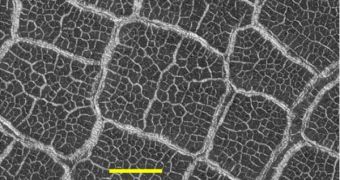According to a new study, the large numbers of cracks that are etched across crater basins on the surface of Mars were created by evaporating lakes. Their properties are consistent with those of similar formations back on Earth, experts from the Max Planck Institute for Solar System Research say. An analytical model reveals that the identified cracks have a maximum diameter of between 43 miles and 87 miles (70 to 140 kilometers), and also that they were most likely caused by evaporation.
What today looks like a planet-wide desert most likely was a lush place, filled with lakes, rivers and deltas, millions of years ago. Ever since ice was first found on the Red Planet, pieces of evidence of a wet past for Mars have been mounting, and every new mission brings something to the table. But, by far, the most successful mission in collecting evidence is the Mars Reconnaissance Orbiter (MRO), which has imaged numerous landscape features that confirm this hypothesis. The Mars Global Surveyor (MGS) has also contributed to shedding light on the planet's history, Space reports.
The structures “resembled the desiccation cracks that we see on Earth in dried up lakes. These are the same type of patterns you see when mud dries out in your back yard, but the stresses that build up when liquids evaporate can cause deep cracks and polygons on the scale I was seeing in the craters,” MPI-SSR expert M. Ramy El Maarry explains. Until now, astronomers and geologists believed that the cracks were caused by the thermal contraction in the planet's permafrost. But models show that such a phenomenon would only generate features 213 feet (65 meters) in diameter.
The actual cracks on Mars are three to 33 feet (one to ten meters) wide, and run extensive lengths. “When a meteorite impacts with the Martian surface, the heat can melt ice trapped beneath the Martian crust and create what we call a hydrothermal system. Liquid water can fill the crater to form a lake, covered in a thick layer of ice. Even under current climatic conditions, this may take many thousands of years to disappear, finally resulting in the desiccation patterns,” El Maarry adds.
Between 4.6 and 3.8 billion years ago, Mars is generally believed to have been covered in water. Some studies, however, point out that the liquid may have flowed on its surface much more recently. This is especially true in the northern hemisphere. The recent analysis was based on images taken with the MGS MOC camera and the HiRISE and Context cameras aboard the MRO.

 14 DAY TRIAL //
14 DAY TRIAL //